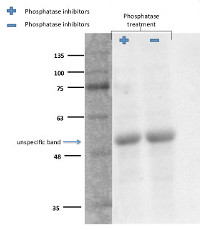1

Anti-S6K1-2 | Ribosomal-protein S6 kinase homolog 1,2 - phosphorylated
AS13 2664 | Clonality: Polyclonal | Host: Rabbit | Reactivity: Arabidopsis thaliana
- Product Info
-
Immunogen: KLH-conjugated peptide containing phospho-Thr, derived from Arabidopsis thaliana S6K1: UniProt: P42818, TAIR: AT3G08730 and S6K2: UniProt: Q39030, TAIR: AT3G08720. Due to high amino acid homology, chosen peptide is conserved in both proteins: S6K1 and S6K2.
Host: Rabbit Clonality: Polyclonal Purity: Immunogen affinity purified serum in PBS pH 7.4. Format: Lyophilized Quantity: 50 µg Reconstitution: For reconstitution add 50 µl of sterile water Storage: Store lyophilized/reconstituted at -20°C; once reconstituted make aliquots to avoid repeated freeze-thaw cycles. Please remember to spin the tubes briefly prior to opening them to avoid any losses that might occur from material adhering to the cap or sides of the tube. Never Store this antibody in 4°C Tested applications: Western blot (WB) Recommended dilution: 1 : 500 (WB) Expected | apparent MW: 52.6 kDa (S6K1) and 53 kDa (S6K2) | 60 kDa - Reactivity
-
Confirmed reactivity: Arabidopsis thaliana Predicted reactivity: Brassica oleracea, Thelungiella halophila
Species of your interest not listed? Contact usNot reactive in: No confirmed exceptions from predicted reactivity are currently known - Application Examples
-
Application example

30 µg of total protein of Arabidopsis thaliana 10 days old seedlings extracted with Lacus buffer with or without phosphatase inhibitors and kept at 4°C prior to denaturation for 5 min. at 95°C. Samples were separated on 6.5 % SDS-PAGE and blotted 2h to PVDF. Phosphatase treatment was done with CIAP ("+" phosphatase inhibitors added, "-" phosphatase inhibitors not included). Blots were blocked with 5% milk in TBST for 1h at room temperature (RT) with agitation. Blot was incubated in the primary antibody at a dilution of 1:500 for overnight at 4C with agitation. The antibody solution was decanted and the blot was washed three times for 15 min in TBS-T at RT with agitation. Blot was incubated in secondary antibody (anti-rabbit IgG horse radish peroxidase conjugated from Agrisera, AS09 602) diluted to 1:10 000 in 2.5% milk in TBST for 1h at RT with agitation. The blot was washed as above and developed for 5 min with ECL according to the manufacturer's instructions. Exposure time was few minutes.
Courtesy of Dr. Rossana Henriques, CRAG, Spain - Additional Information
-
Additional information (application): Following protein extraction, the extract must be promply loaded to SDS-PAGE and not frozen. - Background
-
Background: Ribosomal S6 kinase 1/2 (S6K1/2) involved in TOR signaling pathway, in osmotic stress response. Activated by PDK1 and repressed during osmotic stress. Expressed in all tissues, especially during high metabolic activity in growing buds, root tips, leaf margins and germinating seeds. Alternative names: AtPK1/AtPK6 S6K1), AtPK2/AtPK19 (S6K2).
- Product Citations
-
Selected references: Tanigawa et al. (2024). FYVE1/FREE1 is involved in glutamine-responsive TORC1 activation in plants. iScience. 2024 Aug 26;27(9):110814. doi: 10.1016/j.isci.2024.110814.
Li et al. (2023). Mitigating growth-stress tradeoffs via elevated TOR signaling in rice. Mol Plant. 2023 Dec 5:S1674-2052(23)00396-9. doi: 10.1016/j.molp.2023.12.002.
Primo et al (2022). Plasma membrane H+-ATPases promote TORC1 activation in plant suspension cells. iScience. 2022 Apr 11;25(5):104238. doi: 10.1016/j.isci.2022.104238. PMID: 35494253; PMCID: PMC9046228.
Wang et al. (2022), FERONIA functions through Target of Rapamycin (TOR) to negatively regulate autophagy, Front. Plant Sci., 23 August 2022, Sec. Plant Cell Biology, Volume 13 - 2022, https://doi.org/10.3389/fpls.2022.961096
Yu, Zhong, Ma, et al. (2022) Sulfate-TOR signaling controls transcriptional reprogramming for shoot apex activation. New Phytol. 2022;236(4):1326-1338. doi:10.1111/nph.18441.
González-López et al. (2021). Growth promotion in Arabidopsis thaliana by bacterial cyclodipeptides involves the TOR/S6K pathway activation. Journal of Plant Physiology. Volume 257, 2021, 153343,ISSN 0176-1617, https://doi.org/10.1016/j.jplph.2020.153343.
Kazibwe et al. (2020). TOR mediates the autophagy response to altered nucleotide homeostasis in a ribonuclease mutant. J Exp Bot. 2020 Sep 9;eraa410.doi: 10.1093/jxb/eraa410.
Dealy et al. (2019). CEP3 levels affect starvation-related growth responses of the primary root. J Exp Bot. 2019 Jun 6. pii: erz270. doi: 10.1093/jxb/erz270.
Wang et al. (2017). The inhibition of protein translation mediated by AtGCN1 is essential for cold tolerance in Arabidopsis thaliana. Plant Cell Environ. 2017 Jan;40(1):56-68. doi: 10.1111/pce.12826.
Wang et al. (2017). Reciprocal Regulation of the TOR Kinase and ABA Receptor Balances Plant Growth and Stress Response. Mol Cell. 2017 Dec 27. pii: S1097-2765(17)30930-9. doi: 10.1016/j.molcel.2017.12.002. - Protocols
-
Agrisera Western Blot protocol and video tutorials
Protocols to work with plant and algal protein extracts
Agrisera Educational Posters Collection
- Reviews:
-
This product doesn't have any reviews.



